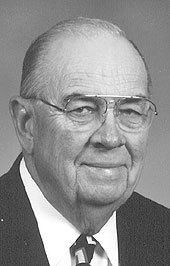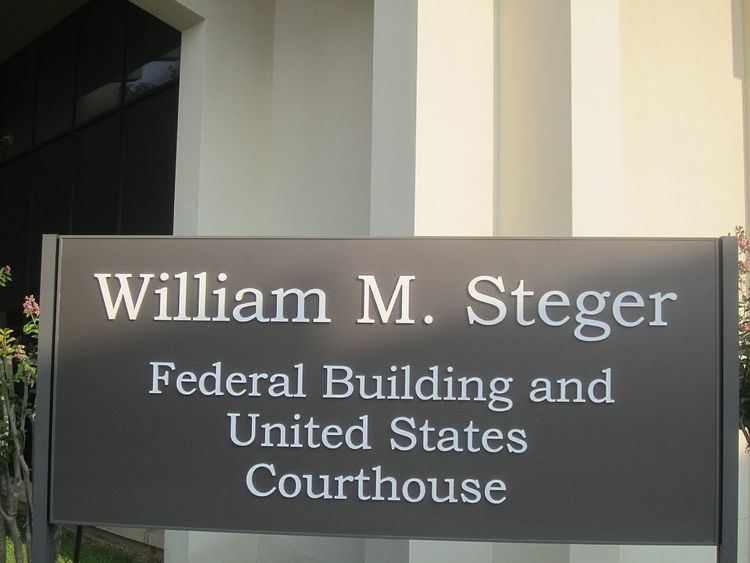Preceded by new seat Preceded by Peter J. O'Donnell Battles and wars World War II | Name William Steger Role Judge | |
 | ||
Spouse(s) Ann Hollandsworth Steger (married 1948-2006, his death) Children Merritt Reed Steger (deceased) Service/branch United States Army Air Corps Education Dedman School of Law, Baylor University, Southern Methodist University | ||
2018 william steger has been killing all summer
William Merritt Steger (August 22, 1920 – June 4, 2006), known as Bill Steger, handled some 15,000 cases in a career spanning more than 35 years as a judge of the United States District Court for the Eastern District of Texas, based in Tyler, Texas. U.S. President Richard M. Nixon appointed Steger to the bench in 1970. Steger was a former chairman of the Texas Republican Party and his party's unsuccessful nominee for governor of Texas in 1960 and for the Texas's 3rd congressional district seat in 1962. Earlier, in 1953, President Dwight D. Eisenhower named him a U.S. Attorney.
Contents
- 2018 william steger has been killing all summer
- Early years education and military service
- Republican political activities
- Tenure on the federal bench
- References

Early years, education, and military service
Steger was born to Merritt Steger and the former Lottie Reese in Dallas and graduated from Woodrow Wilson High School there in 1938. He attended Baptist-affiliated Baylor University in Waco from 1938 to 1941.
After Pearl Harbor was bombed, Steger left Baylor to volunteer for the United States Army Air Corps. He was commissioned a second lieutenant and received his pilot’s wings in November 1942. He flew fifty-six combat missions piloting British Spitfire aircraft in the Tunisian, Sicilian, and Italian campaigns. In recognition for his bravery as a fighter pilot in World War II, Steger received the Air Medal and four Oak Leaf Clusters and attained the rank of captain. Upon returning from overseas until his discharge from the Army in 1947, Steger served as a test pilot in an experimental program to test the first ever military jet aircraft.
After his military service, Steger returned to Dallas and in 1948 married the former Ann Hollandsworth. The couple had one son, Merritt Reed Steger, who predeceased his father. Steger received his law degree in 1950 from the Southern Methodist University Dedman School of Law. Steger then opened his law practice in Longview in Gregg County.
Republican political activities
In Longview, Steger became involved in various Republican activities. He was chairman of the Eisenhower-Nixon campaign in East Texas and was a delegate to the 1952 Republican National Convention, which met in Chicago, Illinois. Thereafter, President Eisenhower named Steger as the United States Attorney for the Eastern District of Texas. This appointment brought him and Mrs. Steger to Tyler, where he served as U.S. attorney until his resignation in 1959. Steger then joined the Tyler law firm of Wilson, Miller, Spivey, and Steger, where he practiced law until 1970. During his years of private practice in Tyler, he continued to remain active in Republican politics.
The Texas GOP nominated Steger as its candidate for governor in 1960. Though he was handily defeated by Democratic Governor Price Daniel, he polled sufficient votes to allow the Republican Party to hold its first presidential primary in Texas in 1964, rather than selecting delegates in caucuses, as had been the custom. Daniel received 1,637,755 votes (72.8 percent) to Steger's 612,963 ballots (27.2 percent). In the Democratic primary for what turned out to have been his last term as governor, Daniel defeated Jack Cox, an oil equipment executive from Houston, who would thereafter switch parties and become the 1962 Republican gubernatorial nominee.
In 1961, Steger became president of the Smith County Republican Men’s Club. In 1962, he challenged veteran Democrat Lindley Garrison Beckworth for the Fifth District seat in the United States House of Representatives. In a narrow loss, Steger received 24,803 votes (48 percent) to Beckworth's 26,915 (52 percent).
Steger was also a Republican presidential elector in 1964, but the Johnson-Humphrey slate easily won Texas that year. In 1966, Steger was elected to the State Republican Executive Committee. In 1967, he was appointed subcommittee chairman of the Texas Republican Task Force on Crime and Law Enforcement. He was a delegate to the 1968 Republican National Convention, which met in Miami Beach, and he was reelected to the State Republican Executive Committee that same year.
In 1969, Steger served as chairman of the Rules Committee at the state Republican Party convention, and later that year was elected state party chairman to succeed Peter O'Donnell, an architect of the Barry Goldwater nomination in 1964. He served through the 1970 elections, which were keenly disappointing to the state GOP, with the defeats of both senatorial and gubernatorial nominees George Herbert Walker Bush and Paul Eggers, respectively.
Tenure on the federal bench
In December 1970, President Nixon appointed Steger to the Tyler-based judgeship, which he held for the remaining thirty-five years of his life.
During his tenure on the bench Judge Steger presided over many noteworthy cases. In 1975, for instance, he held that a private hospital, although it received some state and federal financial support, could establish policies denying use of its facilities for elective abortions. In 1980, he presided over one of the first cases that applied the Racketeer Influenced and Corrupt Organization Act (“RICO”) to obtain the conviction of numerous Gregg County officials for offenses ranging from solicitation of murder to facilitation of gambling.
In 1983, Judge Steger presided over United States v. Rex Cauble, another significant case involving the RICO statute. At the trial of that case, a jury convicted Cauble of masterminding an organization known as the “Cowboy Mafia” that imported tons of marijuana into the United States from South America.
In 1986, he tried United States v. DKG, Inc., a precedent-setting case, which involved the forfeiture of property purchased with funds derived from illegal narcotics transactions. As a result of that conviction, the government seized properties which were subsequently auctioned for more than $10 million and deposited in the U.S. Treasury.
In 1995, Judge Steger named Bryan Hughes, then a recent graduate of Baylor Law School, as his briefing attorney. In 2003, Hughes, a lawyer in Mineola, began service as a Republican member of the Texas House of Representatives from District 5.
Steger died on June 4, 2006, and was interred at the Rose Hill Cemetery in Tyler. The William M. Steger Federal Building and United States Courthouse was named in his honor later that year.
